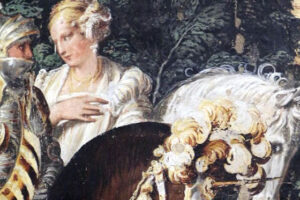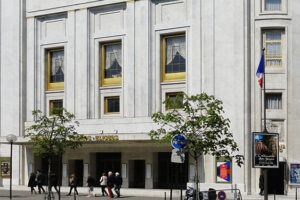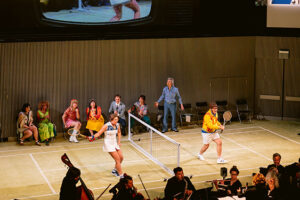

Don’t get me wrong. I love Wolfgang as much as all of you. Yep, of course, the music is sublime and endlessly mineable. But there’s something that happens to me in the final inning of pretty much every single one of his operas: this philistine millennial starts losing interest, and neither a Coney Island reboot nor the lovable Kelli O’Hara can power me through the last half hour of 18th-century slow jams.
I think this is why when I first heard that for its fourth season, intrepid indie company Heartbeat Opera would be presenting Don Giovanni and Fidelio at the Baruch College Performing Arts Center on alternating evenings May 2-13, I imagined there might be something in it for me especially.
Heartbeat is, after all, a company that loves to tinker. If you like your Carmen clutching a cell phone (last year) or your Lucia caged up in the looney bin (year before that), this company, led by visionary directors Louisa Proske and Ethan Heard, is definitely your people.
Every year, I show up ready to be amused by what Proske and Heard make of the classics. And every year, I am astounded to find their lab work at once totally exciting and totally overblown, a turgid mess of what pooped development consultants now refer to as “shiny object syndrome.”
Shiny object syndrome (SOS) is business-speak for overzealous entrepreneurs who are too-easily susceptible to new inspiration and who have trouble boiling all their busy thoughts down to a single, unified plan. Both Proske and Heard have the bug pretty bad, I’m afraid; this year’s double bill of Mozart and Beethoven proves no exception to the rule.
The two productions, which I experienced together back to back on Sunday, both present creative landscapes jam-packed with decent insight and flashes of clarity, but jackhammer away at the works’ inchoate profundity with way, way more gimmicks and gewgaws than we thought we needed.
This is Mozart containing not too many notes, but shall we say a tad too many ideas?
In the case of Don Giovanni, it’s worth stating that SOS constitutes an especially insidious pathology, if only because the work is so awesome, so often mounted, and yet so rarely done well. Our own James Jorden rightly lamented the scarcity of “a really well-staged Don Giovanni” last year in his NYT review of the Mostly Mozart festival’s production at Lincoln Center, reminding readers that for “more than a generation, the Metropolitan Opera has presented a series of genuinely dreadful Don Giovanni stagings: overproduced, silly, illogical and unmusical.”
Heartbeat’s Don G is blessedly far from unmusical or even dreadful, though it is overproduced. In her program notes, director Proske explains that she found the work’s clichés (particularly concerning the female characters) “profoundly untrue,” and so she made a number of interpretive revisions to the text.
In Proske’s rendition, orchestra is pared down to seven pieces (conductor Jacob Ashworth leads Daniel Schlosberg’s new clarinet-heavy arrangement) and personae are catapulted into the present. The title lothario whose bedpost notches 1800 is portrayed as the usual rapey party monster sex addict, albeit one who likes to kavort at the klub sporting Ferragamo slippers, a leopard fur jacket and the latest accessories from Zara. We watch him snake and seduce, boasting of his three recent conquests, Donnas Anna and Elvira, and Zerlina, the last rendered as a vamp.
Having murdered Anna’s father the Commendatore, raped Zerlina and besmirched Elvira, Don Giovanni is soon on the lam, pursued by the three ladies and their male consorts. As in the original, Don Giovanni meets a moralizingly unpleasant end worthy of James Whale, though Proske supplies her anti-hero with a full-blown psychotic crack-up.
In this Don Giovanni, the women are allotted much reconsideration, and have clearly been encouraged to transcend their archetypes. This is particularly evident in the role of Zerlina, often portrayed as a naive but here smartly recast by terrific singing actress Samarie Alicea as a shrewd, gum-smacking moll, a woman whose “Batti, batti” isn’t the stuff of a doormat-masochist but instead a grandly manipulative gesture, aimed at putting her fiancé Masetto in his place.
Similarly, soprano Leela Subramaniam imbued Donna Anna with an attractive stage presence and a spunkiness we don’t often see in a character typically played as a chaste puritan. And the most well-sung of the three in this production, soprano Felicia Moore’s Donna Elvira was more than a harping shrew, but a woman deserving of respect.
But what of the men? The Leporello of Matthew Gamble featured more good acting and singing, albeit with some rather un-Mozartian musical theater melisma on display, prominent in his “Madamina.” The strapping Masetto/Commendatore of bass-baritone Barrington Lee was fine and resonant.
As Don Ottavio, Keith Browning barely registered; I honestly have no recollection of his take on either of two of the finest tenor arias ever written, “Il mio tesoro” and “Dalla sua pace.” (Did they happen at all? Nothing about them in my notes, oddly.)
Gliding across the stage in his leopard fur, John Taylor Ward may have been the twinkiest (I keep autocorrecting to “twinkliest,” which I suppose he was, too) Don Giovanni this side of Seville, sliding in and out of his clothes like a beanpole. His voice had a menacing edge, albeit with a grainy, coarse quality that wasn’t quite seductive enough to make his sexual triumphs believable. I’d have loved to see more charisma out of his Champagne Aria, for instance, which felt a bit too held back and soft-pedaled.
In addition to the cast, a number of inspired details worthy of mention: sets by designer Kate Noll are black-box minimalist but speckled with visual gags, like a “Motel” sign, a “Wanted” poster, and a wretched-looking party replete with one of those uber-trendy photo backdrop things all my friends insist on debasing my Instagram with lately.
Other modern touches, like Leporello brandishing Don G’s “little red book of names” (not black? Is Donny G a comrade?) and modeling a pair of unforgettable bunny ears at one point made for fun viewing.
But then we get mess. Costumes by Beth Goldenberg evoke not so much 17th-century petticoats and farthingales as distracted Patricia Field doing drugs, while experimenting sexually, preparing for a beach party, on the sidelines of a parade.
We get loud party scenes with coke sniffing, mesh crop tops, colored sunglasses, and, in the case of Zerlina, white fishnets, stripper heels, and tulle babydoll dresses, and Masetto dressed as a hipster card shark, washed up and ready to twerk on the shores of South Beach. It’s all just so much.
Naturally, the result of all the happenings on the stage is occasional calamity. So what if the company is still ironing out the kinks? Just a few scenes into act one, moving lights weren’t working and action had to be halted. A Don Giovanni bowtie was dropped, left behind on the floor center stage and stomped on repeatedly by an unknowing (dare I say “naive,” or is that unfeminist?) Donna Anna.
Proske, whose Lucia two years ago will stay with me for a long time, is a tremendous talent, one whose impulses are bold and often absorbing. But four seasons in, her tics as a director are also starting to show. One thing she likes to do, for instance, is take iconic arias out of their place in the narrative and plunk them down somewhere else to lend them an eerie out-of-time feel and perhaps highlight their more ominous qualities.
She did this last year with Carmen’s “Habanera,” shuffling it to the end of the opera so a dead Carmencita could serenade us about love. This year, she took the brilliant aria everyone knows, “Deh vieni alla finestra,” and shoved it to the end of Act 1, to the middle of a quaking Don Giovanni nervous breakdown; so instead of the traditional set-up—luring Elvira’s maid to the window—in this version he sings the song in delirium tremens, shivering and panicking against a flood of dry ice to the strains of minor chords.
Again, I have nothing against a high-concept Don Giovanni. But what I don’t appreciate is the need to take subtlety and bury it beneath an avalanche of screaming, neon exclamation points.
What makes “Deh vieni” ultimately so powerful is that it is in fact a well crafted, lilting love song that also paradoxically foregrounds the inherent cynicism and crookedness of the opera’s protagonist.
Don Giovanni isn’t simply singing pretty here. The trick, rather, is to show that what he is doing is slyly excavating a musical convention and prettily lacing it with menace, corrupting it in much the same lousy way he corrupts society. This is the implicit moral Mozart is offering up with the aria.
All the troubadour’s edginess is already there, in other words, written right into the plucked arpeggios of the mandoline, and you don’t need a literal mental breakdown onstage to show it.
One wonders what else might have been had Proske allowed other zeniths in the music to breathe, or sex addicts to sleaze, on their own terms.

Effects often are mixed. Last year, his cerebral rendering of Butterfly placed themes such as “Orientalism” and “Stereotyping” front and center, calling attention to Puccini’s yucky bits but draining his opera of all of its whimsy and wonder.
This year, his activist slant hasn’t softened: drawing inspiration from present-day realities, Heard locates Fidelio not in the political prison of 18th-century Spain, but in a contemporary American lockup, as well as a time of profound need to recognize that black lives really do matter.
Sets by Reid Thompson do much to enhance this feeling of present-day situatedness. Straight off, the audience finds itself surrounded by prison wire, facing a scaled-back seven-piece band, arranged by Schlosberg, who also conducts from the piano for this production. Musicians wear prison lanyards.
Myriad creative liberties were taken with both scenario and major plot points, some more effective than others. Here, names are tweaked and arias are interspersed with spoken dialogue in English. Action revolves Leah/Leo (Leonore/Fidelio in Beethoven’s time), a woman who disguises herself as a prison guard to rescue her civil rights activist husband Stan (for Florestan, get it?).
Secondary characters include Roc, the African-American deputy major of the prison and his daughter Marcy—Marzelline!—another prison employee who is in love with Leah/Leo the guard. (In this adaptation, it appears Heard has somewhat wisely scrapped Jaquino, Rocco’s assistant who’s in love with Marzelline.)
The villain is venal prison warden Donnie Pizarro, a serial inmate abuser who wishes to execute Stan (as well as the cast’s sole caucasian). Rather more movingly, this production also draws on a prisoners chorus comprised of over 100 currently incarcerated singers and 70 volunteers from six American prison choirs to sing the “O welche Lust”: Oakdale Community Choir, KUJI Men’s Chorus, UBUNTU Men’s Chorus, HOPE Thru Harmony Women’s Choir, East Hill Singers, and Voices of Hope.
Orchestrations are one thing—they’re not great in this outing, overly percussive and dependent on horn and two pianos—but the singing truly is all over the map in terms of quality. As Rocco, Derrell Acon shows a flair for overcoming some clumsy moments in the script (“Any chance you’ll take the leap and start dating?” he eagerly asks Marcy upon sensing his daughter’s lesbian interest in Leah) though his intonation as a vocalist can get shaky.
Bass-baritone Daniel Klein’s villainous Pizarro sings “Ha! Welch’ein Augenblick” with great fire, but wobbles his way through the top of his range.
The women fare a bit better. Having now experienced her Marcy, I can attest that Malorie Casimir is a terrific, natural soprano we’d be blessed to hear more from. As Leah/Leo (which is it? Unclear if she’s a lesbian interest for Marcy?), Kelly Griffin has some beautiful tone up her sleeve, even if the scales were sloppy in her “Abscheulicher! Wo eilst du hin.”
Which brings us to our star prisoner, Stan, played here by Angolan tenor Nelson Ebo. Poor guy, I’m not sure what happened. It was just some of the most ear-splitting, arduous vocalizing I’ve ever heard, as though the larynx had been pinched by a garrote then guillotined at the top of his range. Is some “grauenvolle Stille” too much to ask for, I wondered during his rendition of “Gott! welch Dunkel hier”?
Holding the cast together was a driving need to “educate” the audience. Heard’s program notes inform on the prison industrial complex, proffering bleak statistics on the outsized incarceration rate in America compared to those in other countries, (“violence against black bodies is an ongoing epidemic plaguing out society”) and dedicating his production to those behind bars and the activists who fight for change.
In theory I have few major problems with Heard’s wide-eyed social-commentary approach to opera: he can be a tad indiscreet and ham-handed in his retellings. Projecting video footage of six prison choirs was extremely affecting and nearly moved me to tears; less potent was the black power salute aped by the protagonist or the teacherly activism-talk punctuating the show.
The lesson we got from Heard’s Butterfly remains true for his Fidelio: turning a cardboard character into a vehicle for political messaging doesn’t make the character less cardboard. It makes him a token.
More troubling, however, is Heard’s approach to staging, which is consistently unmusical and more than occasionally, undermines the singing. From loudly wheeling set pieces over Beethoven’s brooding score to splitting duet partners up so they’re on opposite sides of the stage, to repeatedly ripping tape over a key musical moment, to insisting that Stan sing his majestic aria almost entirely supine, Beethoven gets lost far too often. If only Heard could accord real-life prisoners and real-life singers the same respect.
I understand that times are grim for fledgling companies, and I happen to adore Heartbeat Opera for its fearlessness; it absolutely deserves its place in the landscape. But making classical opera relevant doesn’t necessarily mean making it modern, at least not in the sense of setting it in the present and amping up the politics.
Making opera relevant means dusting off the soot, dredging up the ironies, hidden truths, and multiple meanings already ingrained within the scores. And above all, helping an artifact become shiny, complex, and just enough without succumbing to a syndrome of too much for right now.
Photos: Russ Rowland
























Comments